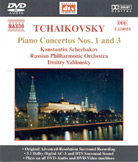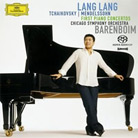August 2004
Why do we buy a particular recording of an established work? One, to have a performance in our collection that we can play repeatedly, enjoying the experience whenever we choose. A second reason would be to hear a new artist and give that musician a chance to come into our listening room to give us, in the best case scenario, some new ideas about a familiar composition. The latter reason is best served by radio stations and over-the-air broadcasts where the buyer can listen before plunking down his cash. These days, if he has paid and finds he has bought a pig in a poke, there is always eBay, where everyone’s trash is someone else’s treasure.
Lang Lang is this year’s Wunderkind. Only 17 when he made this recording, he is an amazing and talented young performer. His technique is sure and his budding sense of lyricism shows great promise. I have no doubt that those in attendance at the Chicago Symphony concerts that gave birth to this recording were completely and totally thrilled. On closer inspection, Lang’s readings are earthbound and show little maturity. He might develop into the next Arthur Rubinstein, but at this point he is a musical stunt, a circus act. No one who is just 17 should be able to play this difficult composition at all! That he can, without dropping a handful of notes on the floor, is impressive. But Lang’s tempos are lugubrious. The elephantine tempo for the famous opening allows Barenboim to inject a lot of saccharine expression into his conducting and the Chicago strings pick it up with wild abandon. This kind of performance made Tchaikovsky a bad name in my college days at the U N C music school. The second movement is slow. Only in the bracing third movement does Lang seem to work with the music instead of against it.
The Russian Philharmonic is a splendid ensemble that realizes the orchestra parts of this concerto in a brilliant manner. Conductor Dmitry Yablonsky works hand in glove with his soloist and elicits glorious playing from his musicians. I would be extremely happy to see this conductor and orchestra record a complete set of Tchaikovsky symphonies and tone poems for Naxos in multichannel sound. Lang plays the Mendelssohn First Concerto as filler for his disc. Again, his performance is somewhat ponderous and misses the mercurial vacillation of lyricism and bravura so necessary to make the piece work. Scherbakov and Yablonsky blaze through the hybrid Tchaikovsky Third Piano Concerto, the first movement of which is Tchaikovsky, the last two arranged and orchestrated by Sergey Taneyav after the composer’s death. This vibrant reading makes it seem like a much better composition than it is. The DG sound is decent, though there is not much stage depth or sense of hall. It sounds like a good recording, nothing more or less. The Naxos sound is magnificent. The piano is largely in the center channel. Though slightly spread to the left and right, the use of the center channel anchors it solidly in place. The orchestra sounds as if placed very slightly behind the piano. There is a good sense of stage depth and the rear channels provide appropriate ambience to place the listener in row 6 of a large concert hall (though the fine print on the cover says it was recorded in a studio in Moscow!) Never have I heard the right-hand piano and upper string doublings in the third movement’s finale sound with such clarity and force. The Naxos recording is also available as a multichannel SACD, which sounds virtually identical to the DVD-Audio disc. No doubt, I will listen to many additional recordings of the famous Tchaikovsky concerto in my lifetime, but will now come back to this one when I want to hear all the work has to offer, in state-of-the-art multichannel sound. GO BACK TO: |
 Tchaikovsky - Piano
Concerto No.1 in B Flat Minor; Piano Concerto No.3 in E Flat Major
Tchaikovsky - Piano
Concerto No.1 in B Flat Minor; Piano Concerto No.3 in E Flat Major Tchaikovsky
- Piano Concerto No.1 in B Flat Minor; Mendelssohn - Piano Concerto No.1
in G Minor
Tchaikovsky
- Piano Concerto No.1 in B Flat Minor; Mendelssohn - Piano Concerto No.1
in G Minor Live performance and recording
provide us with different experiences. What we might find exciting and acceptable in the
moment might prove tiresome and less appealing in the end. Thus it is with these two
advanced-resolution recordings of the familiar Tchaikovsky concerto. Lang Lang’s
performance is worth hearing, but it is the Scherbakov recording one will want to hear
again.
Live performance and recording
provide us with different experiences. What we might find exciting and acceptable in the
moment might prove tiresome and less appealing in the end. Thus it is with these two
advanced-resolution recordings of the familiar Tchaikovsky concerto. Lang Lang’s
performance is worth hearing, but it is the Scherbakov recording one will want to hear
again.  Turning to the Naxos release, one is struck
immediately by the difference in its opening. Scherbakov’s chords are the best
registered I have ever heard and propel the piece forward to heroic heights. Nothing
sentimental here, this is strong, noble music, hopeful and uplifting in spite of the minor
key. Scherbakov is scarcely a household word in the U S, but Naxos’ biographical
notes indicate he is very highly regarded in Russia and Europe and that he has some 50
concertos in repertory. He has a wonderful sense of lyricism and can play oh so
delicately, but when called on to supply a bravura passage, he is there in full force. His
playing reminds me most of that of the late Sviatoslav Richter.
Turning to the Naxos release, one is struck
immediately by the difference in its opening. Scherbakov’s chords are the best
registered I have ever heard and propel the piece forward to heroic heights. Nothing
sentimental here, this is strong, noble music, hopeful and uplifting in spite of the minor
key. Scherbakov is scarcely a household word in the U S, but Naxos’ biographical
notes indicate he is very highly regarded in Russia and Europe and that he has some 50
concertos in repertory. He has a wonderful sense of lyricism and can play oh so
delicately, but when called on to supply a bravura passage, he is there in full force. His
playing reminds me most of that of the late Sviatoslav Richter.